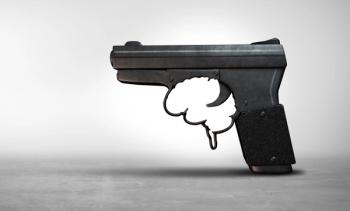
- Vol 38, Issue 9
9/11 20th Anniversary: COVID-19 Endgame
How has human behavior been affected by the tragedy of 9/11 and the recent trauma of the COVID-19 pandemic?
On this 20th
One of the most unsettling aspects of the pandemic has been the amount of uncertainty surrounding it. The pandemic has surprised and confused us because we are watching it all unfold in real time: Variants arise, and medical decision-making requires continuous flexibility and updating.
It seems intuitive that the COVID-19 pandemic would significantly affect global mental health.4 However, since all this is developing contemporaneously, it is difficult to be certain. We are left to infer that children and adolescents are probably more likely to be vulnerable to depression and anxiety during and after isolation ends.5 Yet a recent review and meta-analysis found that the“psychological impact of COVID-19 lockdowns is small in magnitude and highly heterogeneous.”6 How can this be? Any amount of time spent watching news media assures us that social unrest, ideological division, and urban violence have been escalating. Frequency and magnitude aside, there can be no denying such remarkable events as the
Proximal and Distal Defenses
A reasonable estimation at the current time is that there are “widely varying ways in which people have responded to the COVID-19 pandemic.”3 But it is the general commonalities of response I would like to address, and for which TMT has relevant explanations. For 35 years, TMT research has suggested that individuals employ both proximal and distal defenses in response to death terror. Proximal defenses are used for death thoughts that are the conscious subject of current attention. Such defenses include suppression, denial, and behaviors designed to reduce vulnerability. Current-day examples might include trivializing the impact of the virus, or even denying its existence. Proximal behaviors of greater utility might include employing social distancing, hand-washing, and mask-wearing. In contrast, the distal defenses are unconscious and/or on the periphery of consciousness. Distal defenses are focused on maintaining faith in one’s worldview, enhancing self-esteem, and finding outlets for symbolic immortality. A present-day example might include adopting a strikingly polarized, ideological narrative about the virus—as can be currently seen in the absurd, almost comical, political polarization of the pandemic.
A common challenge in the face of tragedy and death terror is the tension between these proximal and distal defenses. Post 9/11, the tension was between securing air travel and national security (proximal defenses) and our ability to freely travel and visit loved ones (distal defense interruption). During COVID-19, the
This death terror tension places us in a precarious situation. Consider the aftermath of the 9/11 response: For the first time in history, all nonemergency airflight in the United States was immediately grounded, leaving virtually all citizens without freedom of travel to see family. Further, the 9/11 attacks precipitated the invasion of Afghanistan, which in turn became the United States’ longest and most expensive war. To say that 9/11 and its aftermath impacted civil liberties, privacy, and freedom would be an understatement. A similar death terror tension can be seen during the COVID-19 pandemic, where large social gatherings (concerts, protests, political rallies, etc) have directly put large numbers of individuals in danger of disease. In such situations, the need for meaningful social interaction and/or symbolic immortality has the paradoxical effect of increasing risk of death. When faced with a conflict of extremes, finding a middle path or compromise is often a reasonable option.
The Will to Survive
Whenever tragedy strikes and produces a no-win situation, as it often does, I am always reminded of the masterpiece play written by Nobel laureate Samuel Beckett titled Endgame. It is an existentialist-absurdist play about the will to survive in the face of deep despair and meaninglessness. The play, which premiered in 1957 at London’s Royal Court Theatre, “portrays a universe which is nearing its end but which could continue repeating itself; the end which all seem to be moving toward is both certain and elusive.”7 The setting is suggestive of a post- apocalyptic scenario in which the characters “pass the time mortifying each other and toying with fears and illusions of a possible change, all along sensing the inevitability of their end.”8 The entire play takes place in a partially underground room for the 4 characters: Hamm (the master), Clov (the servant), and Nagg and Nell (Hamm’s father and mother). Hamm is in a wheelchair and orders Clov around the room and to look out the window for signs of life. But outside, there appears to be no such signs—nothing, in fact, but gray skies.
Consider the similarities between Endgame and both 9/11 and recent circumstances. To start, the characters stay in a single, bleak room and are left to face “isolation, claustrophobia, loss, nostalgia, and an extremely tight and structured repetitive form.”8 Much of Beckett’s work contains similar themes (eg, Waiting for Godot). This was because Beckett, who was deeply affected by WWII, developed the belief that “life itself is absurd, and this incurs reactions of both black mirth and profound despair.”9 For example, at one point in Endgame, the character Hamm states, “You’re on Earth, there’s no cure for that!” Beckett does not attempt to deny or soften his message that “human existence is characterized by suffering, decay, and isolation as we crawl towards death.”8 Yet despite the pain, monotony, and absurdity, it can be argued that Endgame’s overarching message is positive. The play’s existential slow burn ultimately leaves us with compassion for the human condition. Despite the characters’ awareness of the absurdity and meaninglessness of human life, they persevere with attempts to construct meaning through language and imagination. One interpretation of Beckett’s message is: In the midst of negation, I revolt – and I do this by creating meaning. I laugh when I can, accept what I must, and persevere to the best of my ability. This is the same sentiment Camus demonstrates when he wrote the Myth of Sisyphus and imagined him happy: “The struggle itself… is enough to fill a man’s heart.”10
In a sense, death-denying cognitions are a form of a wish. Held up to the light of day, this wish is for nothing other than a compensatory sense of triumph over reality. But of course, reality cannot be overcome, and to maintain such a stance toward life is to increase one’s suffering. The fact that we spend so much energy denying this truth must ultimately lead us down the road of compassion. It is perhaps one of our biggest challenges as a species and has been so for most of recorded history. The ancient Japanese described the challenge wisely and poetically: “There is a saying of the elders that goes, ‘Step from under the eaves and you’re a dead man. Leave the gate and the enemy is waiting.’ This is not a matter of being careful. It is to consider oneself as dead beforehand.”11 In other words, the end was built in as soon as we entered consciousness. Surrendering to and accepting the
3 Antidotes
What lessons might incomprehensible tragedies like 9/11 or pandemics have for us when our death-denying maneuvers have exhausted themselves and our defenses have been rendered ineffective? The lessons of psychology, philosophy and human nature suggest we might consider these 3 antidotes: compassion, compromise, and creativity.
Compassion is not weakness, nor is it passive. Rather, it is emotionally challenging, daring, and life-altering. Certainly, when we practice compassion, we can expect to experience fear and pain. Our conscious existence is a series of plays put on by characters and voices in our heads, and this is the same for everyone until the end. This alone is cause for compassion. Compassion for the human condition teaches us to relax and move gently toward our fears. The benefits accrue when we slowly relinquish our hardened aversion to mortality and allow our fear to increase our flexibility.
Compromise should be familiar to psychiatrists and psychoanalysts. Life requires continuous compromise, as the pandemic has taught us. The compromises may be practical and concrete, such as using telemedicine or wearing masks in public. Or the compromises may be less discernable—such as intrapsychic or existential compromises. For example, we may know that we have only so many years left (if lucky) to spend time with elderly relatives. Not wanting to risk harm to them and/or others, we compromise by seeing them virtually and feeling more gratitude for the fewer in-person visits we might have left with them. Regardless, note that to achieve successful compromise, it is critical that we do not ask more of the world than it can possibly deliver. Since the pandemic is still unfolding and narratives remain unfinished, there will be plenty of opportunity for compromise.
As writer Melissa Fay Greene noted in a 2021 article in The Atlantic, “Sometimes you just have to come to terms with the world as it is, and to human beings as they are, rather than how we wish the world and people were.”12 Greene observes that the pandemic has given rise to a theme: “…[I]n the worst of times, even as many people surprised us with their indifference,” some have “managed to cross barriers and offer us kindness, compassion, alliance, and strength.”
This finally brings us to creativity, which requires imagination and leads to innovation. Analysts who understood drive theory might relate creativity to libido or life force. Creativity is freeing and motivating. When a society has become paralyzed with fear, it is at risk of losing touch with its creativity, resulting in less freedom, diminished perspectives, and stagnated innovation. Even when afraid, we should cultivate human creativity because it is among our greatest and most reliable strengths. Our capacity for creativity gives birth to meaning and, thus, direction and purpose.
Concluding Thoughts
The Buddhist tradition teaches that sitting meditation is a practice to carry into one’s daily life. When the current of the mind whisks us away, we notice this, and then return to the present. This pattern is an eternal recurrence throughout our lives. Repeatedly, we are hit by both small waves and devastating tsunamis. The practice of bringing ourselves back to reality trains the mind to return to a state of equanimity. We are reborn into the present—over and over. By being continually reborn, we may yet transcend the uncertainty, absurdity, and fear that limit us.
Dr Knoll is professor of psychiatry and director of forensic psychiatry at SUNY Upstate Medical University in Syracuse, New York, and clinical director of Central New York Psychiatric Center in Marcy, New York. He is Emeritus Editor-in-Chief of the Psychiatric TimesTM and President-elect of the American Academy of Psychiatry and the Law (2022-23).
Acknowledgments: The author would like to acknowledge the help and insights of Ron Pies, MD, and the inspiration of David Keith, MD.
References
1. Knoll JL IV. 9/11 10th Anniversary: a mortality salience reminder. Psychiatric Times. September 9, 2011. Accessed August 9, 2021.
2. Knoll JL IV. Panic and pandemics: the return of the absurd. Psychiatric Times. March 30, 2020. Accessed August 9, 2021.
3. Pyszczynski T, Lockett M, Greenberg J, Solomon, S.
4. Alzueta E, Perrin P, Baker FC, et al.
5. Loades ME, Chatburn E, Higson-Sweeney N, et al.
6. Prati G, Mancini AD.
7. Fajardo-Acosta F. Endgame. 2002. Accessed August 9, 2021.
8. An analysis of Beckett’s Endgame—the human condition. The Science Snail. May 29, 2018. Accessed August 9, 2021.
9. Wenaus A. “Zero, zero, and zero”: Beckett’s Endgame, automation, and zero player games. Chiasma. 2017;4:74-103. Accessed August 9, 2021.
10. Camus A. The Myth of Sisyphus. Penguin Classic; 1975.
11. Tsunetomo Y, Wilson WS. Hagakure: The Book of the Samurai. Kodansha International; 1979:164.
12. Greene MF. You won’t remember the pandemic the way you think you will. The Atlantic. Published online April 6, 2021. Accessed August 9, 2021.
Articles in this issue
about 4 years ago
The State of Mental Health of Black Women: Clinical Considerationsover 4 years ago
What Do I Do Now? Making Decisions in a Postpandemic Worldover 4 years ago
A Generation in Crisis?over 4 years ago
Treating Mania in Older Adults With Bipolar Disorderover 4 years ago
Inclusivity: Ensuring Patients Who Are Plus-Size Feel Welcomeover 4 years ago
Art Imitating Life: A Poet’s Wordsover 4 years ago
Fraternity Paddleover 4 years ago
Harnessing Harm-Reduction Methods to Combat the Opioid CrisisNewsletter
Receive trusted psychiatric news, expert analysis, and clinical insights — subscribe today to support your practice and your patients.













